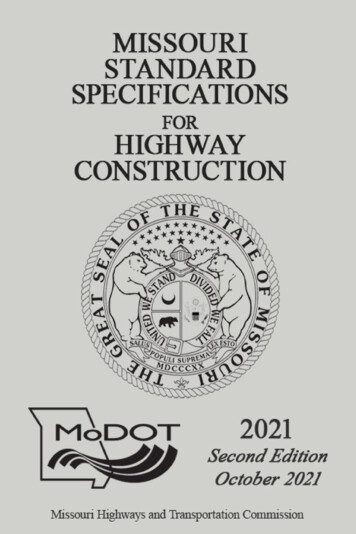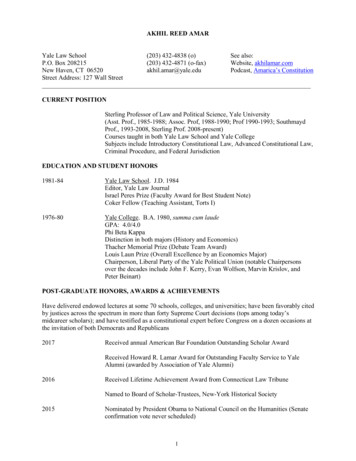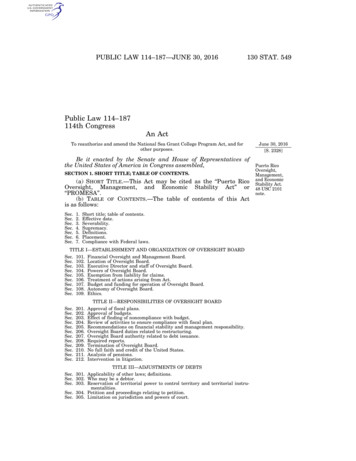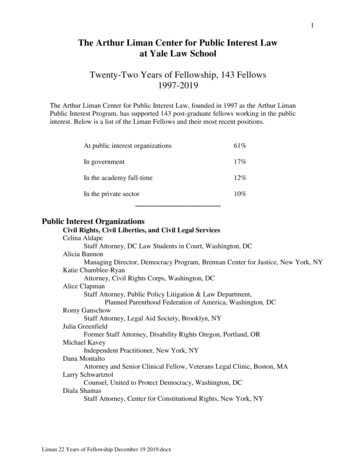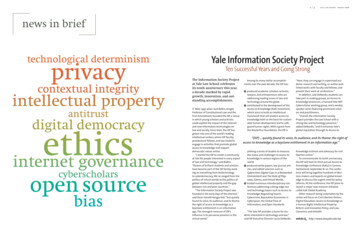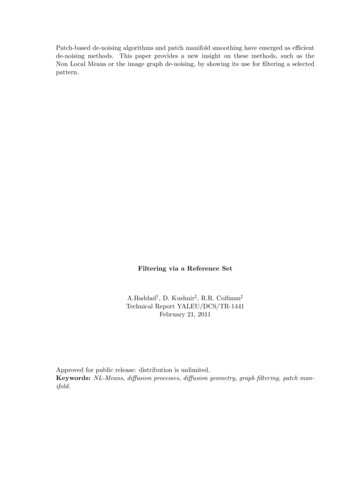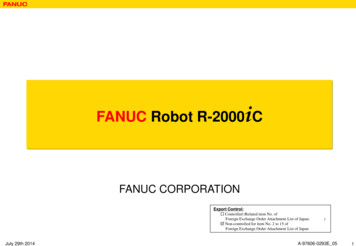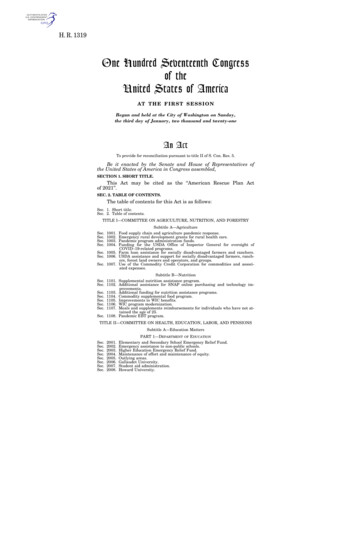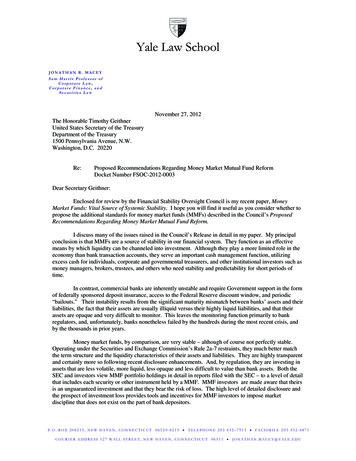
Transcription
Yale Law SchoolJONATHAN R. MACEYSam Harris Professor ofCorporate Law,Corporate Finance, andSecurities LawNovember 27, 2012The Honorable Timothy GeithnerUnited States Secretary of the TreasuryDepartment of the Treasury1500 Pennsylvania Avenue, N.W.Washington, D.C. 20220Re:Proposed Recommendations Regarding Money Market Mutual Fund ReformDocket Number FSOC-2012-0003Dear Secretary Geithner:Enclosed for review by the Financial Stability Oversight Council is my recent paper, MoneyMarket Funds: Vital Source of Systemic Stability. I hope you will find it useful as you consider whether topropose the additional standards for money market funds (MMFs) described in the Council’s ProposedRecommendations Regarding Money Market Mutual Fund Reform.I discuss many of the issues raised in the Council’s Release in detail in my paper. My principalconclusion is that MMFs are a source of stability in our financial system. They function as an effectivemeans by which liquidity can be channeled into investment. Although they play a more limited role in theeconomy than bank transaction accounts, they serve an important cash management function, utilizingexcess cash for individuals, corporate and governmental treasurers, and other institutional investors such asmoney managers, brokers, trustees, and others who need stability and predictability for short periods oftime.In contrast, commercial banks are inherently unstable and require Government support in the formof federally sponsored deposit insurance, access to the Federal Reserve discount window, and periodic“bailouts.” Their instability results from the significant maturity mismatch between banks’ assets and theirliabilities, the fact that their assets are usually illiquid versus their highly liquid liabilities, and that theirassets are opaque and very difficult to monitor. This leaves the monitoring function primarily to bankregulators, and, unfortunately, banks nonetheless failed by the hundreds during the most recent crisis, andby the thousands in prior years.Money market funds, by comparison, are very stable – although of course not perfectly stable.Operating under the Securities and Exchange Commission’s Rule 2a-7 restraints, they much better matchthe term structure and the liquidity characteristics of their assets and liabilities. They are highly transparentand certainly more so following recent disclosure enhancements. And, by regulation, they are investing inassets that are less volatile, more liquid, less opaque and less difficult to value than bank assets. Both theSEC and investors view MMF portfolio holdings in detail in reports filed with the SEC – to a level of detailthat includes each security or other instrument held by a MMF. MMF investors are made aware that theirsis an unguaranteed investment and that they bear the risk of loss. The high level of detailed disclosure andthe prospect of investment loss provides tools and incentives for MMF investors to impose marketdiscipline that does not exist on the part of bank depositors.P.O. BOX 208215, NEW HAVEN, CONNECTICUT 06520-8215 TELEPHONE 203 432–7913 FACSIMILE 203 432-4871COURIER ADDRESS 127 WALL STREET, NEW HAVEN, CONNECTICUT 06511 JONATHAN.MACEY@YALE.EDU
The proposals currently under review by the Council are similar to those previously under reviewby the SEC, and I address them generally in my paper. Specifically, the Council has proposed torecommend that the SEC require MMFs to have a floating net asset value (“NAV”) instead of a stableNAV, adopt capital requirements with certain other limitations, or impose minimum balance at riskrequirements for MMFs, also together with capital. I am unaware of any data to support the propositionthat any of these structural changes would make MMFs less at risk of sustained redemptions in a financialcrisis, and I presume the Council’s task will be to determine whether there is evidence that any of theproposals, in fact, would accomplish its purpose. In its review, I would strongly urge the Council to giveserious study to the potential impact that any of measures could have in destabilizing the financial systemby weakening the role of MMFs.For example, a “floating” NAV would reduce investor demand for MMFs, because of operational,tax, accounting, or legal impediments, or because of convenience and efficiency considerations. Likewise,a holdback or minimum balance requirement will deter investors for many of the same reasons. Theincreased costs that would be imposed by a capital requirement will have to be borne by someone – andeither will reduce investor demand or deter MMF sponsors. While I have not studied the Council’s releasein detail, it appears that the drafters concede that the impact of these changes very well could be to reduceMMF assets, but they discount the economic impact of a smaller MMF industry by concluding that MMF’srole in providing credit to the economy is relatively small, and the increased cost of short-term financing byissuers whose commercial paper or other debt instruments MMFs purchase likewise would be relativelysmall.The data supporting these conclusions obviously needs to be scrutinized and tested, and I hope theCouncil will do so. In addition, the Council also must consider the potential impact of a diminished MMFindustry on increasing systemic risk – the Council’s core concern. If MMFs are not available or their roleis significantly reduced, investors will seek other places to place cash, such as less transparent, lessregulated private funds, individually managed accounts, or short-term investment funds. It also seemslikely that investors would increase their reliance on banks. Yet history has shown that MMFs are morestable than banks, even without the explicit government support that banks receive. As noted above, bankshave proved to be less stable due to the maturity mismatch of their assets and liabilities, the illiquid natureof their assets, and their opacity to investors. A reduced MMF industry may lead to the flow of largeamounts of cash into this problematic system, especially through the largest banks, and increase pressure onthe FDIC.I understand that a key goal of government policy under the Dodd-Frank Act was to endgovernment bailouts and reduce the risk posed by “too big to fail” systemically important financialinstitutions. Any action by the Council (or the SEC pursuant to its recommendation) that would cause thelargest banks to grow even larger would seem fundamentally at odds with the purpose of the statute thatcreated the Council, because it would add, and not reduce, risk to the financial system. If the Council’s aimis to reduce systemic risk, reduce the chances of other bailouts, and at the same time ensure the availabilityof short-term financing for borrowers that seek an alternative to banks, then the Council should carefullyevaluate how its proposed recommendations would affect the flow of short-term cash investments fromMMFs and into the banking system, and the impact of such a shift on systemic risk.I hope that the Council will find the enclosed paper helpful as it considers whether the proposedrecommendations are warranted.Sincerely,Jonathan R. Maceycc:Ben S. Bernanke, Chairman of the Board of Governors of the Federal Reserve System2
Richard Cordray, Director of the Consumer Financial Protection BureauEdward DeMarco, Acting Director of the Federal Housing Finance AgencyGary Gensler, Chairman of the Commodity Futures Trading CommissionMartin Gruenberg, Acting Chairman of the Federal Deposit Insurance CorporationDebbie Matz, Chairman of the National Credit Union AdministrationMary Schapiro, Chairman of the Securities and Exchange CommissionThomas Curry, Comptroller of the CurrencyS. Roy Woodall, Jr., Independent Member with Insurance ExpertiseJohn P. Ducrest, Commissioner, Louisiana Office of Financial InstitutionsJohn Huff, Director, Missouri Department of Insurance, Financial Institutions, and ProfessionalRegistrationDavid Massey, Deputy Securities Administrator, North Carolina Department of the Secretary ofState, Securities DivisionMichael McRaith, Director of the Federal Insurance OfficeLuis Aguilar, Commissioner, Securities and Exchange CommissionDaniel Gallagher, Commissioner, Securities and Exchange CommissionTroy Paredes, Commissioner, Securities and Exchange CommissionElisse Walter, Commissioner, Securities and Exchange CommissionAmias Gerety, Deputy Assistant Secretary for the Financial Stability Oversight CouncilCraig Lewis, Director, SEC Division of Risk, Strategy, and Financial InnovationKarrie McMillan, Investment Company Institute3
money market funds:vital sourceof systemicstability Jonathan R. Macey
1 Money Market Funds:Vital Source of Systemic Stability Jonathan R. MaceyCONTENTSI. INTRODUCTION . 3 II. MONEY MARKET FUNDS . 5 A. Rule 2a-7: A Success Story In Flexible Regulation. 6 III. CONTEMPLATED REGULATORY OPTIONS WILL INCREASE SYSTEMIC RISK AND MAKE THE FINANCIAL SYSTEM LESS EFFICIENT AS WELL AS LESS SAFE.11 IV. THE ECONOMIC FUNCTION OF MMFS .13 A. The Real Lessons to Be Learned from Reserve Primary Fund.19 i. Why Money Markets Are Vastly More Stable than Banks .24 1. Matching Assets and Liability Structure.24 2. MMFs Offer Greater Transparency.25 3. Higher Quality Holdings .26 4. Shares vs. Debt.26 5. MMF’s Do Not Cause Credit Market toSeize Up (But Bad Government Policy Can).28
Money Market Funds: Source of Systemic StabilityV. HOW A THRIVING MMF INDUSTRY HELPSTO STABILIZE OUR FINANCIAL SYSTEM .29 A. MMFs Diversify Risk by Reducing Pressure on the FDIC.29 B. MMFs Can Reduce Systemic Risk So Long as TheyAre Subject to Their Own Regulatory Scheme.30 C. MMF’s Provide Liquidity .32 i. Commercial Paper .32 ii. Repurchase Agreements .33 VI. SIFI DESIGNATION: TREATING MMFS LIKE BANKS .35 VII. FLOATING NAV .37 VIII. MINIMUM BALANCE AT RISK REQUIREMENTS.41 IX. CAPITAL REQUIREMENTS.43 X. CONCLUSION .44 APPENDIX: MMFS IN HISTORICAL CONTEXT.47 BIOGRAPHY .59
3 MONEY MARKET FUNDS: VITAL SOURCE OF SYSTEMIC STABILITY Jonathan R. Macey*I. INTRODUCTIONMoney Market Funds (MMFs) are one of the few investment vehicles inthe history of finance that permit assets to be deployed in the economy andstill remain stable without implicit or explicit government support. As a vitalmeans through which liquidity may be efficiently channeled into investment,MMFs have served as a stunning success story spanning the past four decades.These vehicles have provided corporate and governmental treasurers, moneymanagers, brokers, trustees, escrow agents, governmental treasurers, and retailinvestors with modest returns, liquidity, and stability that banks have been unable to match. As such, MMFs have grown to become a stabilizing cornerstoneof our economy.Throughout the recent Financial Crisis, and peaking shortly after the collapse of Lehman Brothers Holdings, Inc. (“Lehman”) in September 2008, therewas a flight to quality that affected all sorts of financial institutions and investment classes. As part of this flight to quality, many prime money market fundinvestors rushed to redeem their shares and move funds into government securities and government money market funds.1 This influx of sellers caused concernthat some MMFs would drop below their target price of 1.00 per share – an extremely rare, and nerve rattling, occurrence known as “breaking the buck.” OneMMF did – the Reserve Primary Fund. Though oft cited by regulators, the storyof the Reserve Primary Fund was more an example of that fund’s unique circumstances and management failures than evidence of industry-wide vulnerability.2*Sam Harris Professor of Corporate Law, Corporate Finance, and Securities Law, Yale Law School (on leave, fall 2012). See page59 for biography.1“Prime” money market funds invest in high-quality, short term debt instruments issued by companies and state, local and federalgovernment entities. “Government” money market funds invest only in government securities, such as Treasuries. As discussedfurther below, in response to the issues that affected money market mutual funds in late 2008 after Lehman Brothers’ bankruptcyfiling, the SEC made significant changes to the regulation of such funds. See Securities And Exchange Commission, MoneyMarket Fund Reform, Inv. Co. Act. Rel. no. 29,132 (Feb. 23, 2010) hereinafter “SEC Rel. No. 29132,” (available at http://www.sec.gov/rules/final/2010/ic-29132.pdf ); see also Benjamin J. Haskin, Margery K. Neale and Ryan P. Brizek, SEC AdoptsMoney Market Fund Reforms, The Metropolitan Corporate Counsel, Inc., (April 5, 2010), http://www.metrocorpcounsel.com/current.php? art-Type view&artMonth November&artYear 2010&EntryNo 10803. Report of the President’s WorkingGroup on Financial Markets, Money Market Fund Reform Options (Oct. 2010) [hereinafter “PWG Report”] s/Pages/tg918.aspx.The Reserve Fund had overinvested in Lehman debt and its managers then allegedly “falsely claimed they would prop up thefund’s 1.00 net asset value even though they ‘secretly harbored’ doubts.” While other funds received sponsor support anddid not break the buck, the Reserve Fund was unique and now faces an SEC civil lawsuit. Kirsten Grind, Broken Fund Shiftsthe Blame, Wall Street Journal (Aug. 16, 2012) at 90444233104577593550400166844.html?mod djemEditorialPage h&mg reno-wsj. The SEC and Federal Reserve Bank of New York had personnelphysically inside Lehman’s offices and reporting to Washington in March-September of 2008.2
Money Market Funds: Source of Systemic StabilityThough this marked only the second time in history that an MMF’s shareprice fell below 1.00 since the product’s creation in 1971,3 the pressure onprime MMFs during “Lehman Week” provoked the SEC to enhance its regulations of MMFs in rules adopted in 2010.4 Not satisfied with the SEC’s roundof enhancements to Rule 2a-7 in 2010, the SEC Chairman has expressed support for three additional restrictions on MMFs:1. Eliminating the current stable net asset value (NAV);2. Imposing capital requirements; and3. Imposing a holdback or minimum balance requirement.Such measures have been advocated as recently as September 2012 by TimothyGeithner.5 This study concludes that each of these advocated reforms are misguided and threaten to destabilize the financial system. Specifically, each changewould decrease efficiency, dampen competition, and hinder capital formation.6This paper provides an analysis of MMFs to show that MMFs significantlyreduce systemic risk. The contemplated changes to the way that MMFs are currently regulated would inevitably increase systemic risk by weakening the role ofMMFs in the financial markets and by increasing market participants’ relianceon commercial banks.7 MMFs would no longer serve as a viable alternative; thiswould dampen competition and increase the cost of short-term capital funding. The “likely economic consequences” of the advocated changes would bedetrimental to the SEC’s stated objectives.8 In fact, the weight of the evidencesuggests that adoption of these changes would be arbitrary and capricious.This paper reviews the role served by MMFs in the financial markets andquestions the assertion that MMFs pose systemic risks to the financial system.It starts by demonstrating the central role that MMFs have come to play in ourfinancial system. Subsequently, the paper explains the operation of these fundsin layman’s terms and compares them to bank instruments. This paper nextconsiders the role of MMFs in the recent financial crisis. This paper shows that3 4 5 6 7 8 The first occurrence, described below, was in 1994 when concerns over exposures to interest rate derivatives led investors towithdraw from a particular fund that had taken excessive risk.SEC Rel. No. 29132 supra n. 1.Department of Treasury Letter to Members of the Financial Stability Oversight Council (Sept. 27, 2012), available at .Geithner.Letter.To.FSOC.pdf.Statutes applicable to SEC rulemakings mandate that the SEC consider the impact of proposed regulations on efficiency,competition, and capital formation.Jonathan Macey, Reducing Systemic Risk The Role of Money Market Mutual Funds as Substitutes for Federally Insured BankDeposits, 17 Stan. J.L. Bus. & Fin. 131, 135 (2011).See SEC Memorandum to Staff of the Rulewriting Divisions and Offices from the Division of Risk, Strategy, and FinancialInnovation Overview and Office of the General Counsel (Mar. 16, 2012) available at http://www.sec.gov/divisions/riskfin/rsfi guidance econ analy secrulemaking.pdf. [hereinafter SEC Mar. 2012 Memo]. As of the date of this Paper, it appears thatthe majority of SEC Commissioners have, at least initially, resisted such changes, but other regulators are continuing to press fortheir implementation.
5 the financial crisis was neither caused nor exacerbated by MMFs, and describesadvantages and stability that these funds provide investors. Finally, this paperreviews the current system of regulation of MMFs and further changes that areunder consideration, and argues that over-regulation of MMFs may destroytheir utility and increase systemic risk.9II. MONEY MARKET FUNDSMMFs are regulated by the SEC under the Investment Company Act of1940. First launched in 1971, MMFs were created as a convenient alternative tothe direct investment of temporary cash balances. As such, they invest in shortterm “money market” instruments such as Treasuries, commercial paper, andnegotiable CDs, thereby allowing their customers to enjoy returns while stillmaintaining liquidity. Investors are able to gain access to their investment by“redeeming” their shares, i.e., simply demanding to receive their cash equivalent.10Unlike other mutual funds, money market mutual funds were better ableto maintain a stable NAV of 1.00 per share. MMFs have accomplished thisstability by not only minimizing their risk exposure but also by buying onlyshort-term debt securities from financially stable issuers who pose little risk ofdefault prior to maturation.11 In this way, MMFs provide investors with bothsafety and liquidity, while still seeking out higher returns than those offered bybank interest rates.Supportive of radical, and likely fatal, regulatory changes to the MMFindustry, Mary Schapiro, the Chairman of the SEC, has attempted to bolster the fallacious argument that MMFs are unstable by erroneously assertingthat MMFs have faltered and found themselves in need of sponsor support on“more than 300 occasions.”12 Specifically, Ms. Schapiro asserts that:When, despite risk-limiting provisions, money market fund assetshave lost value, fund “sponsors” (the asset managers – and their corporate parents – who offer and manage these funds) have used theirown capital to absorb losses or protect their funds from breaking thebuck. Based on an SEC staff review, sponsors have voluntarily provided support to money market funds on more than 300 occasionssince they were first offered in the 1970s.139 10 11 12 13 Macey, supra n. 7, at 132-3.Macey, supra n. 7, at 134.Id. at 135.Mary Schapiro, Testimony Before the Committee on Banking, Housing, and Urban Affairs of the United States Senate on“Perspectives on Money Market Mutual Fund Reforms” (June 21, 2012) at .htm.Id.
Money Market Funds: Source of Systemic StabilityUpon examination, this assertion that 300 MMFs were bailed out by theirsponsors turns out to be untrue. The data actually shows, in fact, that at least20% of the funds listed by the SEC as “receiving sponsor support” never actually received any.14 Another 71% of the funds listed did not need supportto avoid breaking the buck. In all, after taking into account all of the variouserrors in the Chair’s analysis, over 91% of the funds on the list (286 of the313 funds) either did not receive support or were not “rescued” insofar as theywould not necessarily have broken a dollar without the sponsor’s support.15Thus, receipt of sponsor support does not necessarily mean that a fund is indistress. It should also be noted that virtually all of the cited instances of sponsor support occurred before the SEC’s 2010 amendments to its rules governingmoney market funds which strengthened the liquidity and credit quality ofMMF portfolios.Moreover, it is important that the handful of occasions in which sponsorsupport is provided not be misconstrued from a policy perspective. Forms ofsponsor support for MMFs include purchasing defaulted or devalued securitiesout of a fund at par or amortized cost, providing a capital support agreementfor the fund, and sponsor-purchased letters of credit for the fund.16 No gooddeed goes unpunished, however, and the SEC Chair has indicated – erroneously – that this sort of financial support is a sign of weakness. The notion thatsupport is a sign of vulnerability rather than a sign of strength is wrong, both asa matter of logic and as a matter of established regulatory philosophy.17A. Rule 2a-7: A Success Story in Flexible RegulationA large number of factors can cause the NAV of even well-managed MMFsto fall below or rise above 1.00. For example, a swift upward adjustment ininterest rates could reduce the value of portfolio securities below the 1.00NAV level. Some classes of assets held by the fund could decline in value.18 Asthe average maturity of the securities in an MMF’s portfolio increases, so toodoes the possibility that the NAV will vary somewhat from 1.00. Althoughmost attention is paid to NAVs potentially falling below 1.00, a fund’s NAVcould also exceed 1.00. Either way, the MMFs seek NAV stability.1914 15 16 17 18 19 Federated’s Analysis: Misleading the Public Regarding the Risks of Money Market Funds – A Review of “Studies” of SponsorSupport for their Funds. Available at rature/44949.pdf.Id.Macey, supra n. 7, 134.Division of Banking and Supervision and Regulation SR Letter 09-4, at 2 (February 24, 2009) (revised March 27, 2009). 2009/SR0904.htm.As discussed in the context of the 2010 reforms infra.Macey, supra n. 7, at 138.
7 Towards this end, MMFs employ the amortized cost method to accountfor the difference between the purchase price and the amount payable at maturity using amortization. “The basic premise underlying MMFs’ use of the amortized cost method of valuation is that high-quality, short-term debt securitiesheld until maturity will eventually return to the amortized cost value and arenot ordinarily expected to fluctuate significantly.”20Originally created in 1983, Rule 2a-7 permitted MMFs to employ thispractice provided they invest in securities rated “high quality” by a major rating service, or otherwise determined by the board to be of comparable qualityof such securities.21 Further, 2a-7 required that the MMFs “’maintain a dollarweighted average portfolio maturity appropriate to its objective of maintaininga stable net asset value per share,’ which could not exceed 120 days.” Individualportfolio securities must mature within 397 days.22 The rule was designed toenable MMFs to use amortized cost valuation if they strictly and precisely follow its risk-limiting regulations.Prompted by the precipitous fall of Lehman in 200823 and the pro-regulatory environment that followed the unprecedented financial crisis, the SECamended 2a-7 in 2010. While originally questioning whether to scrap the ruleand instead require MMFs to offer and redeem their shares at a fluctuatingNAV, the SEC ultimately decided to amend, rather than repeal, 2a-7. Despitethe lingering debate over floating NAV, the 2010 amendments left the “principles of Rule 2a7 intact – strict limits on credit and interest rate risks coupledwith a high degree of diversification.”24With the regulatory goal of making sure that the term “money marketmutual fund” retains its meaning for investors, the SEC in 2010 imposed avariety of additional regulatory requirements on any mutual fund that “hold[s]itself out to investors as a money market fund or equivalent.”25 The goal of thereforms was to directly address the issue that had arisen in 2008: liquidity.Under the amended rules, funds may only refer to themselves as MMFsif, among other requirements, they: (1) invest only in securities that the fund’sboard of directors determines present minimal credit risks; (2) invest only insecurities that are rated “in one of the two highest short term rating categories”20 21 22 23 24 25 Macey, supra n. 7, at 164.Investment Company Institute, Report of the Money Market Working Group, (Mar. 17, 2009), Appendix E at www.ici.org/pdf/ppr 09 mmwg.pdf [hereinafter ICI Report]; Stephen Keen, 2010 Money Market Fund Regulatory Reforms, 43 Rev. of Sec. &Com. Reg. 191, 191 (2010) http://www.rscrpubs.com/Cover Keen RSCR 8-25-10.pdf.Id. at E-150, E-156.The failure of Lehman Brothers in September 2008 was precipitous from the markets’ perspective, but had been anticipatedby the federal government for at least six months (but the full extent of Lehman’s financial difficulties was not disclosed to themarkets prior to its bankruptcy). See Report of Anton R. Valukas, Examiner at 8, 609, In re Lehman Brothers Holdings Inc.,No. 08‐13555 (Bankr. S.D.N.Y.), http://jenner.com/lehman.Keen, supra n. 21, at 191.17 C.F.R. § 270.2a-7.
Money Market Funds: Source of Systemic Stabilityof Nationally Recognized Statistical Rating Organizations (NRSROs) or others determined to be of comparable quality;26 (3) invest only in securities thatmature within 397 calendar days of the date they are purchased; and, (4) meetvery strict liquidity and portfolio diversification requirements: a.) satisfyingdaily and/or weekly Liquid Asset standards whenever they acquire a security,b.) limiting illiquid securities (i.e., “securities that cannot be sold or disposed ofin the ordinary course of business within seven calendar days at approximatelythe value ascribed to them by the [money market] fund”) holdings to 5%, andc.) on top of 10% daily and 30% weekly liquidity requirements, maintainingsufficient liquidity “to meet reasonably foreseeable shareholder redemptions.”27In practice, this has resulted in prime MMFs holding well over 40% of theirportfolios in seven-day liquid assets, a percentage roughly triple the percentageredeemed from prime MMFs in the seven days after Lehman failed in September 2008.28 The greatly enhanced liquidity required by the 2010 amendmentsallows MMFs to meet extraordinarily high levels of redemptions from internalportfolio cash without selling assets. This ability supports the premise behindthe use of amortized cost accounting that portfolio assets will be held to maturity. This liquidity also enables MMFs to pay cash to redeeming investors evenif the underlying money markets become illiquid.Under the amended rule, an MMF using the “amortized cost method willbe able to treat as liquid a security that the fund can sell at a price that deviatesfrom the security’s amortized cost value, as long as the price approximates themarket-based value that the fund has ascribed to the security for purposes ofdetermining its shadow price.”29Moreover, MMFs are generally prohibited from investing more than 5%of their total assets in securities from any one issuer, and are prohibited fromallocating more than 3% of fund assets to nongovernmental securities that arenot in the highest rating category. Perhaps most critically, MMFs must have “adollar-weighted average portfolio maturity appropriate to its objective of maintaining a stable net asset value per share” and in no event can an MMF have adollar-weighted average maturity that exceeds 60 days.3026 27 28 29 30 Id.See amended rule 2a-7(c)(5)(ii)-(iii). See also amended rule 2a-7(a)(8) (defining “daily liquid assets”); 2a-7(a)(32) (defining“weekly liquid assets”); (infra notes 229-243) and accompanying text. “Total assets” means with respect to a money market fundusing the amortized cost method, the total amortized cost of its assets and, with respect to any other money market fund, thetotal market-based value of its assets. See amended rule 2a-7(a)(27). SEC Rel. No. 29132 supra n. 1.Fitch Ratings, Study of MMF Shadow NAV Shows Stability (June 14, 2012), available at: s/Study-of-MMF-Shadow-NAV-Shows-Stability.jsp.SEC Rel. No. 29132, supra n. 1, at 56 n. 210. The deviation between the fund’s NAV “calculated using available marketquotations (or an appropriate substitute which reflects current market conditions)” and its amortized cost value per share, aprocess commonly referred to as “shadow pricing.”Id. at 185.
9 To heighten the rigor of regulation further, the 2010 amendments m
propose the additional standards for money market funds (MMFs) described in the Council's . Proposed . Recommendations Regarding Money Market Mutual Fund Reform. I discuss many of the issues raised in the Council's Release in detail in my paper. My principal . conclusion is that MMFs are a source of stability in our financial system.
